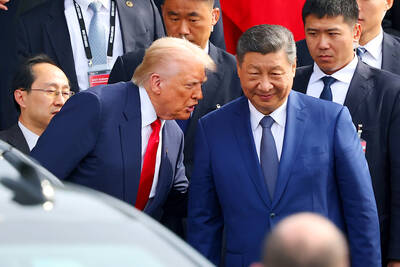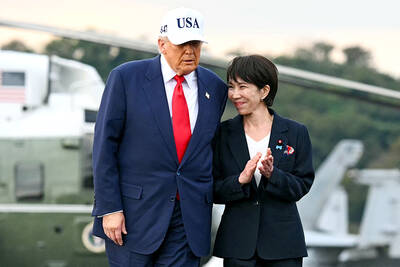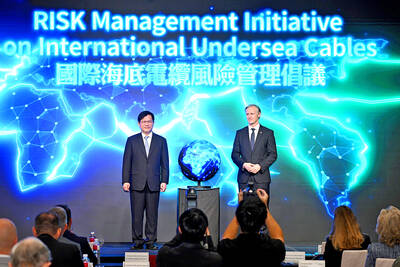A major new Pentagon report on the Chinese military says China is on track to build a modern military by 2020 and that despite improvements in relations across the Taiwan Strait, Taiwan remains the principal focus of the Chinese military.
Fueled by its booming economy, China’s military growth in the past decade has exceeded most US forecasts.
Its aircraft carrier program, cyber warfare capabilities and anti-satellite missiles have alarmed neighbors and Washington, the long-delayed comprehensive 84-page report says.

Photo: Wang Min-wei, Taipei Times
While the report contains nothing that is startlingly new, it is dominated by references to Taiwan. And it comes just weeks before the administration of US President Barack Obama has promised to provide an answer to Taipei’s request to buy 66 advanced F-16C/D aircraft.
This potential arms sale is not mentioned, but without actually spelling it out the study makes it abundantly clear that Taiwan is in desperate need of new weapons.
Titled Military and Security Developments Involving the People’s Republic of China 2011, the annual report to Congress from the US Department of Defense makes chilling reading.
The Obama administration continues to deny that a decision has yet been made on whether or not to sell the F-16s, but unofficial sources in both Taipei and Washington are signaling that Obama will bow to Chinese pressure and not allow the sale. Instead, he seems likely to offer to modernize Taiwan’s dated F-16A/B aircraft — a move that is less objectionable to Beijing.
China’s rise as a major international actor will stand out as a defining feature of the strategic landscape of the early 21st century, the report says.
And China’s modernized military could be used in ways that increase Beijing’s ability to gain diplomatic advantage or resolve disputes in its favor, the report says.
Nowhere is that more the case, the report makes obvious, than in Beijing’s dealings with Taiwan.
“The PLA [People’s Liberation Army] seeks the capability to deter Taiwan independence and influence Taiwan to settle the dispute on Beijing’s terms,” it says.
“In pursuit of this objective, Beijing is developing capabilities intended to deter, delay, or deny possible US support for the island in the event of conflict,” it says.
“The balance of cross-Strait military forces and capabilities continues to shift in the mainland’s [China’s] favor,” it says.
Despite the warming cross-strait ties under President Ma Ying-jeou (馬英九), the report says, China has continued to build its forces in a way that threatens Taiwan.
“In the current decade to 2020, the PLA is likely to steadily expand its military options for Taiwan,” it says.
“Consistent with a near-term focus on preparing for Taiwan Strait contingencies, China continues to base many of its most advanced systems in the military regions opposite Taiwan,” it says.
On top of the huge numbers of ballistic and cruise missiles aimed at Taiwan, the report says China bases 490 combat aircraft within operational range of Taiwan and has the airfield capacity to expand that number by hundreds, as well as about 400,000 of its 1.25 million soldiers based in three military regions opposite Taiwan.
“The possibility of a military conflict with Taiwan, including US military intervention, remains a pressing, long-term focus for the PLA,” the report says.
“In the absence of a peaceful cross-Strait resolution or long-term non-aggression pact, the Taiwan mission will likely continue to dominate PLA modernization and operational planning,” it says.
Although the Chinese military probably lacks the necessary military power to successfully conduct a full-scale amphibious invasion of Taiwan, the report says, it is working to close the gaps in its capabilities.
“Furthermore, Taiwan’s relatively modest defense spending has failed to keep pace with ambitious military developments on the mainland,” it says.
The report says Beijing seeks to deter Taiwanese moves toward independence and seeks to achieve unification with a carrot and stick approach.
“The PRC [People’s Republic of China] strives to integrate the two economies while advancing cultural and historic ties. Politically, China has sought to expand ties with the [Chinese Nationalist Party] KMT Party on Taiwan while attempting to isolate political entities with more overtly pro-independence leanings,” it says.
“The PRC employs economic enticement, propaganda, and political engagement in pursuit of these objectives,” it says.
According to the report, the military component of China’s strategy is intended to create an impression on Taiwan that accommodation with Beijing is ultimately in Taiwan’s best interest.
“Beijing appears prepared to defer the use of force as long as it believes long-term reunification [sic] remains possible and the costs of conflict outweigh the benefits,” it says.
US Deputy Assistant Secretary of Defense for East Asia Michael Schiffer told a Pentagon press briefing on the report that the pace and scope of China’s sustained military investments had allowed Beijing to pursue capabilities that “we believe are potentially destabilizing to regional military balances, increase the risk of misunderstanding and miscalculation, and may contribute to regional tensions and anxieties.”
He said the report pointed to cross-strait trends that created a very challenging military and security environment.
The US was committed to working with Taiwan, to meet its -commitments under the Taiwan Relations Act (TRA) and to ensure that Taipei had the self-defense capabilities that it needed, Schiffer said.
Asked directly about the possible sale of F-16C/Ds, Schiffer said: “There have been no decisions that have been made on arms sales to Taiwan.”
“This is an issue that we continue to work with on a daily basis and consistent with our obligations under the Taiwan Relations Act, the United States will provide to Taiwan the self-defense capabilities that it requires,” he said.
“It’s a challenging security environment across a number of different dimensions,” he said when pressed on the possible sale.
There was no “silver bullet that will all of a sudden change everything,” he said.
In Taipei, the Ministry of National Defense again urged the US government to speed up the sale of defensive weapons to Taiwan.
Ministry spokesman David Lo (羅紹和) said the report again highlighted the cross-strait military imbalance.
Based on this reasoning, Ma has repeatedly called on the US to supply defensive arms to Taiwan in accordance with the TRA, Lo said.
He said the ministry has continued in its efforts to persuade Washington to provide F-16C/D aircraft, F-16A/B upgrades and diesel-electric submarines.
The Chinese government has yet to give its official response to the report, but Xinhua news agency fired the first shot in an English-language commentary yesterday, condemning the report as an alarmist “cock-and-bull story” that was “based on a wild guess and illogical reasoning.”
“China, which has adhered to a defensive military policy, with its rising economic clout and sprawling commercial and strategic interests around the world, has every right to build a competent military,” it said.
Xinhua called the Pentagon’s conclusions “much ado about nothing,” and said Chinese people thought it “baffling” that the US could criticize China when its own military spending was 40 percent of the world’s total last year.
Additional reporting by Reuters and CNA

UKRAINE, NVIDIA: The US leader said the subject of Russia’s war had come up ‘very strongly,’ while Jenson Huang was hoping that the conversation was good Chinese President Xi Jinping (習近平) and US President Donald Trump had differing takes following their meeting in Busan, South Korea, yesterday. Xi said that the two sides should complete follow-up work as soon as possible to deliver tangible results that would provide “peace of mind” to China, the US and the rest of the world, while Trump hailed the “great success” of the talks. The two discussed trade, including a deal to reduce tariffs slapped on China for its role in the fentanyl trade, as well as cooperation in ending the war in Ukraine, among other issues, but they did not mention

Japanese Prime Minister Sanae Takaichi yesterday lavished US President Donald Trump with praise and vows of a “golden age” of ties on his visit to Tokyo, before inking a deal with Washington aimed at securing critical minerals. Takaichi — Japan’s first female prime minister — pulled out all the stops for Trump in her opening test on the international stage and even announced that she would nominate him for a Nobel Peace Prize, the White House said. Trump has become increasingly focused on the Nobel since his return to power in January and claims to have ended several conflicts around the world,

GLOBAL PROJECT: Underseas cables ‘are the nervous system of democratic connectivity,’ which is under stress, Member of the European Parliament Rihards Kols said The government yesterday launched an initiative to promote global cooperation on improved security of undersea cables, following reported disruptions of such cables near Taiwan and around the world. The Management Initiative on International Undersea Cables aims to “bring together stakeholders, align standards, promote best practices and turn shared concerns into beneficial cooperation,” Minister of Foreign Affairs Lin Chia-lung (林佳龍) said at a seminar in Taipei. The project would be known as “RISK,” an acronym for risk mitigation, information sharing, systemic reform and knowledge building, he said at the seminar, titled “Taiwan-Europe Subsea Cable Security Cooperation Forum.” Taiwan sits at a vital junction on

LONG-HELD POSITION: Washington has repeatedly and clearly reiterated its support for Taiwan and its long-term policy, the Ministry of Foreign Affairs said US Secretary of State Marco Rubio yesterday said that Taiwan should not be concerned about being used as a bargaining chip in the ongoing US-China trade talks. “I don’t think you’re going to see some trade deal where, if what people are worried about is, we’re going to get some trade deal or we’re going to get favorable treatment on trade in exchange for walking away from Taiwan,” Rubio told reporters aboard his airplane traveling between Israel and Qatar en route to Asia. “No one is contemplating that,” Reuters quoted Rubio as saying. A US Treasury spokesman yesterday told reporters